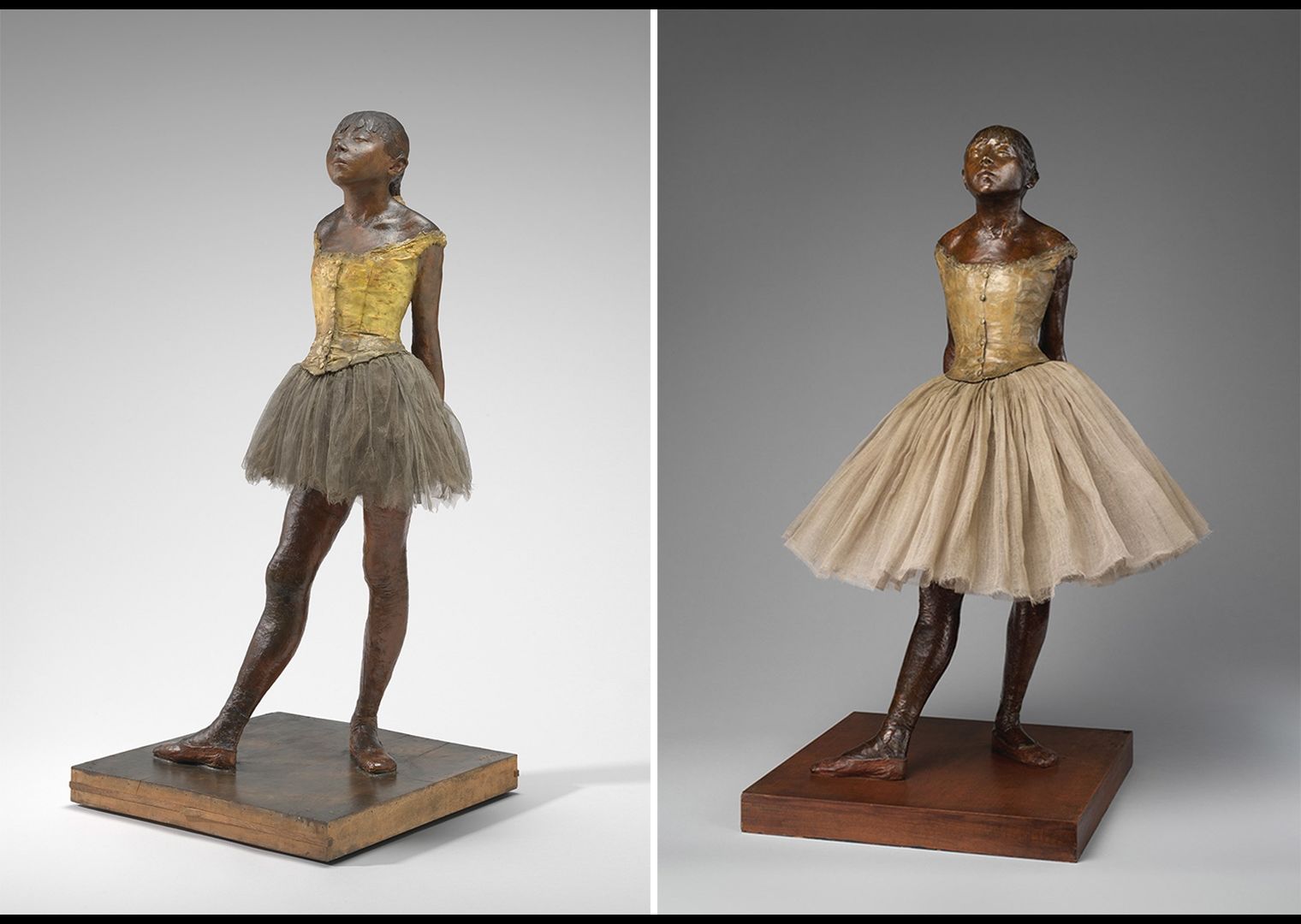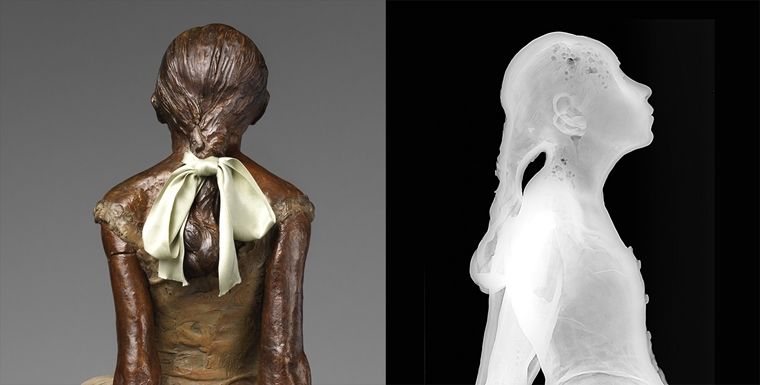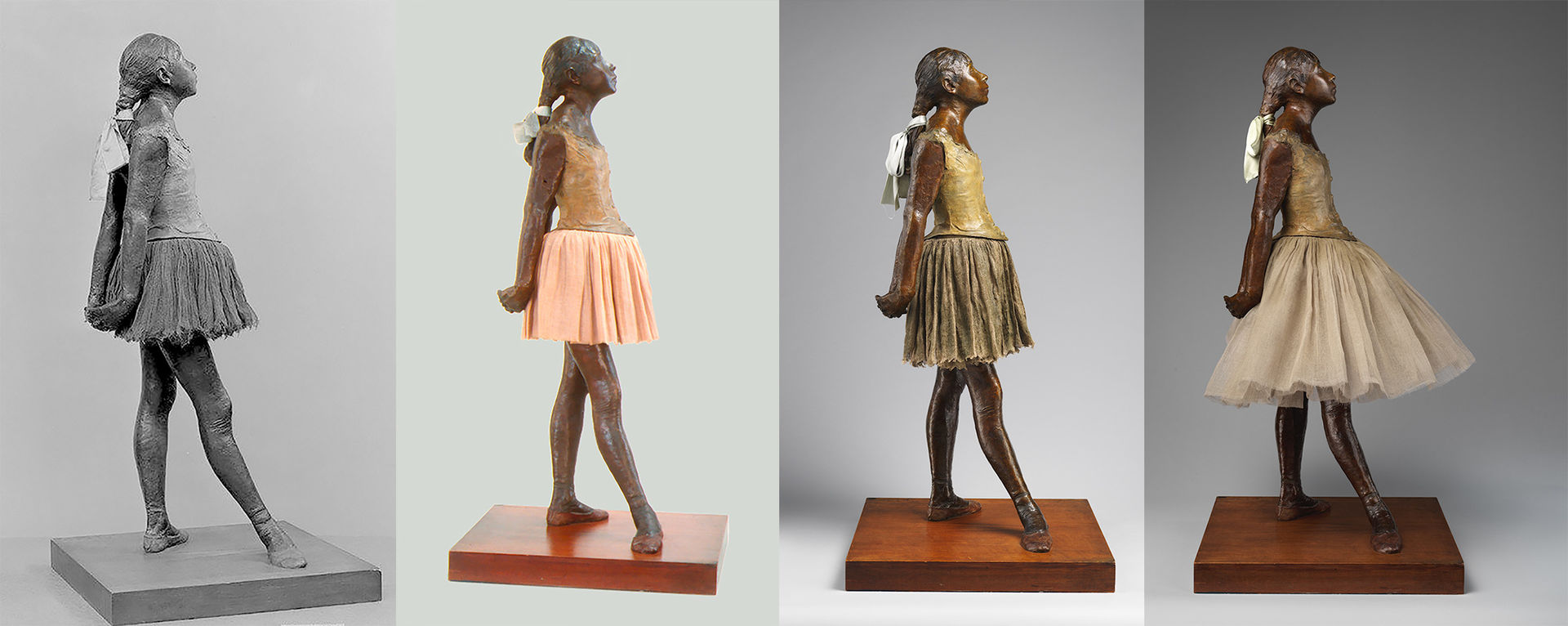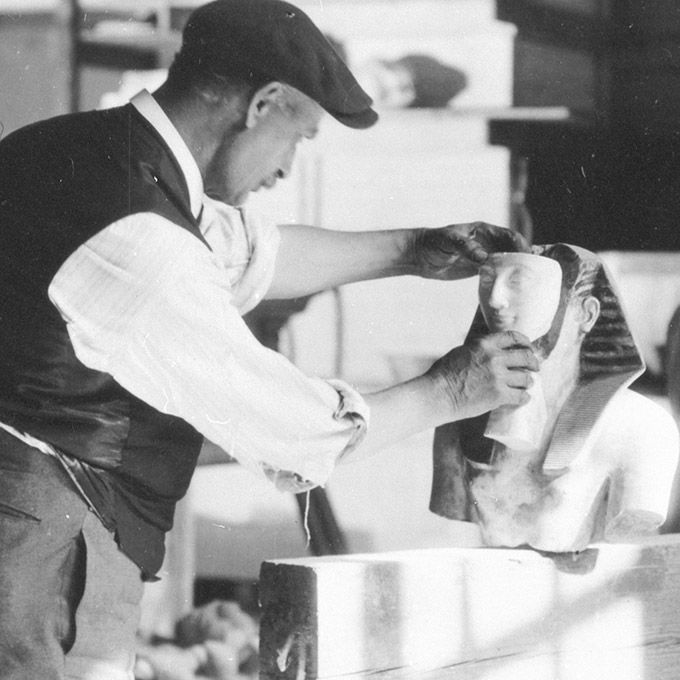
The Evolution of Degas’s Little Dancer
Glenn Petersen, Conservator, Costume Institute, and Linda Borsch, Conservator, Department of Objects Conservation
The Met's bronze cast of Degas's Little Fourteen-Year-Old Dancer has captivated generations of visitors since it was acquired in the bequest of Mrs. H. O. Havemeyer in 1929, but many admirers may not be familiar with the material transformation of the sculpture—from wax to bronze and through a series of custom-fitted skirts—since Degas exhibited the original version in 1881.

The Little Dancer, sculpted in beeswax (left) and cast in bronze (right)
Left: Edgar Degas (French, 1834–1917). Little Dancer Aged Fourteen, 1878–81. Pigmented beeswax, clay, metal armature, rope, paintbrushes, human hair, silk and linen ribbon, cotton faille bodice, cotton and silk tutu, linen slippers, on wooden base. Overall without base: 39 x 13 6/8 x 13 7/8 in. (98.9 x 34.7 x 35.2 cm); weight: 49 lb. (22.226 kg). The National Gallery of Art, Washington, D.C., Collection of Mr. and Mrs. Paul Mellon (1999.80.28). Right: Little Fourteen-Year-Old Dancer, 1922 (bronze cast); 2018 (tutu). French, Paris. Cast by A. A. Hébrard (Paris). Partially tinted bronze, cotton tarlatan, silk satin, and wood. Overall with base and tutu: 38 1/2 x 17 1/4 x 14 3/8 in. (97.8 x 43.8 x 36.5 cm). The Metropolitan Museum of Art, New York, H. O. Havemeyer Collection, Bequest of Mrs. H. O. Havemeyer, 1929 (29.100.370)
Degas's original sculpture (above, left) was made of unorthodox materials: tinted beeswax skin, a human-hair wig, a cotton bodice, linen ballet slippers, and tarlatan tutu. The only sculpture he exhibited during his lifetime, it was both hailed and criticized for its uncanny realism. On a visit to the artist's studio with Mary Cassatt in 1903, Louisine Havemeyer asked to purchase the figure. Degas toyed with the idea of making a cleaner wax copy or casting it in bronze, but Havemeyer wished only to obtain the original, with which the artist was unwilling to part.
Upon his death in 1917, Degas's heirs decided to reproduce his sculptures in bronze, stirring up debate about the artist's intentions. In addition to Little Dancer, many of the artist's wax, clay, and plastilene sculptures were discovered in damaged or fragmentary condition in his studio. A longtime friend of Degas, sculptor Paul-Albert Bartholomé, helped select and repair seventy-two of these for a limited-edition series of bronzes. To stay true to the originals, the Paris foundry A. A. Hébrard, which specialized in lost-wax casting, was instructed to avoid cleaning up the sculptures before taking the molds. The quality of the Hébrard bronzes is extraordinary; master founder Albino Palazzolo was awarded the Legion of Honor in recognition of the skill and sensitivity of his work. With Cassatt's help, Havemeyer secured the first cast of the bronzes and gave sixty-nine of them to The Met. Since the gelatin molds were damaged in the process, these first bronzes retain details lost in subsequent casts.

Left: The Little Dancer at The Met (detail). Right: X-ray imaging reveals only a few areas of internal porosity, not visible on the exterior, in the upper figure
If you look closely at The Met's Little Dancer, you will see details of the original faithfully replicated in bronze, from the texture of the wax-covered hair and bodice to flaws like the crack in the dancer's left arm, which was later corrected in the original version. X-ray imaging reveals that the sculpture was expertly cast in one thin, hollow form. Compositional analysis, by research scientists at The Met, has identified the casting metal as a ternary alloy of copper, tin, and zinc, similar to that found in a recent technical study of Degas sculptures undertaken by the National Gallery of Art, Washington, D.C.

The Little Dancer wearing a succession of skirts, from left to right: original skirt made in 1922; replacement skirt made in 1968; 1998 replica of an early skirt for a bronze cast; 2018 tutu based on the original wax sculpture, made possible with the support of Monika A. McLennan and children
Curators at The Met have replaced the fabric skirt at least three times in the past to address either its deterioration or their dissatisfaction with its appearance. In 2018, Costume Institute conservator Glenn Petersen collaborated with curators to design and fabricate a new tutu, intended to suggest more closely Degas's vision for Little Dancer (far right).
We hope you will enjoy the above video, where Glenn discusses the history of the sculpture and the decisions made in the conservation of its tutu.
Related Content
Edgar Degas, "Little Dancer Aged Fourteen," The National Gallery of Art
150th Anniversary: Conservation Stories
Go behind the scenes with iconic Met objects and see what happens when science meets art.
Celebrate the 150th anniversary with special events and projects all year long.

